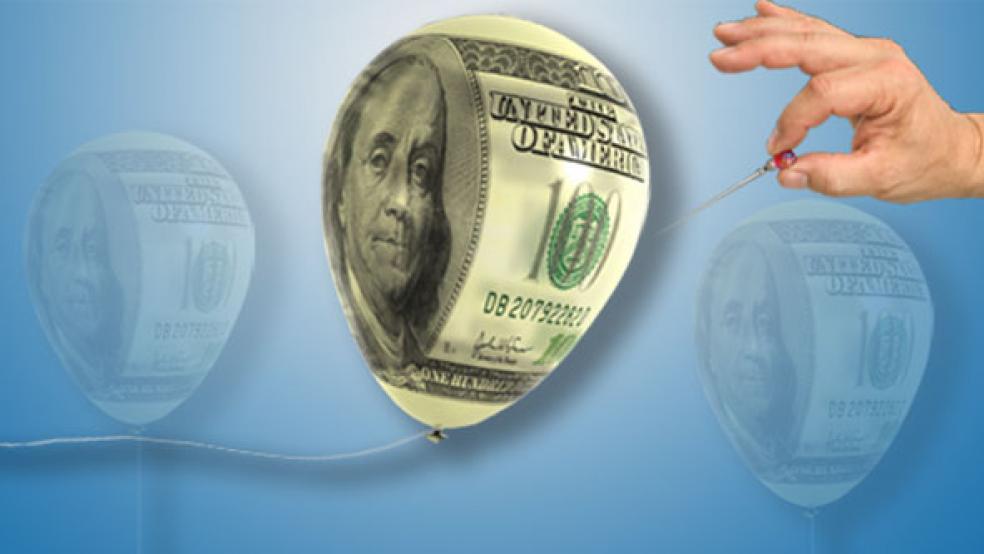As recently as this spring, everybody knew that the greatest economic risk on the horizon was inflation. All the economists said so. The government was borrowing like mad from the Chinese and channeling the money into every member of Congress’ favorite public projects. The Federal Reserve was conjuring dollars out of thin air and handing them out like free chips at the Bellagio’s roulette table. It was, in the words of Grant’s Interest Rate Observer’s Jim Grant, “aggressive, premeditated debasement of the currency.”
We should have known. In the financial markets, what everyone agrees is going to happen rarely does —at least not until after everyone has agreed that something else is inevitable. Not only has inflation not risen, it has fallen drastically, from 2.3 percent in March to 1.1 percent in June. Worrying about rising prices now seems as alarmist as losing sleep over avian flu.
The new nightmare scenario is the other “flation,” in which prices fall and dollars become scarcer and more valuable. In a deflationary cycle, slack demand begets falling prices, and falling prices beget even slacker demand because buyers hold on to their money, expecting prices to go lower still. Once it takes hold, it’s devilishly hard to stop. Japan, for example, has been circling the deflationary drain for 20 years. In the 1990s — Japan’s “lost decade” — deflation took hold after a collapse in the stock and real estate markets (sound familiar?), and the Japanese economy grew just 1.5 percent a year. Japanese policymakers fought back by lowering interest rates to near zero and undertaking massive deficit spending. How did that work out? Not so well: Growth in this decade averaged just 0.8 percent.
virtue. Government spending needs to be reined in,
taxes raised and deficits shrunk like tumors.
A number of economists have warned about an outbreak of deflation here, including Nobel laureate Paul Krugman and Carmen Reinhart and Kenneth Rogoff, authors of This Time It’s Different, the influential history of past financial crises. But the deflationistas got an important new convert in James Bullard, president of the St. Louis Federal Reserve, a one-time inflation hawk who last week published a white paper called “The Seven Faces of The Peril” (the peril being you-know-what). The paper has become a scary bedtime must-read for economists. The money quote: “The U.S. is now closer to a Japan-style outcome than at any time in recent history.”
For those of us outside the dismal science, this shift in the wind raises some queries, the first being the “what, again?” question. Why should you think that deflation, so far from the headlines this spring, won’t fade back to obscurity by October as we move on to worrying about some new peril? There are four reasons, it seems to me, to take deflation seriously.
The recovery, such as it is, has lost all momentum. If the Great Recession did indeed hit bottom in the summer of 2009, we should be much farther along the path to prosperity than we are. While economists generally shrugged at the 2.4 percent second-quarter GDP growth reported last week (hey, at least it was a positive number), David Rosenberg, chief economist at the Canadian investment firm Gluskin Sheff, found it seriously wanting:
What is “normal” in the context of a post-WWII recovery is that four quarters into it, real GDP expands at over a 6 percent annual rate. That puts 2.4 percent into a certain perspective. And, with the revisions now showing the downturn deeper, the level of economic activity in real terms is still 1 percent below the prerecession peak. Again, when you look back at 55 years worth of postwar data, what is normal 2.5 years after a recession begins is that by now we are at a new peak (on average, breaking above the prior high in GDP by 8 percent).
In normal recoveries, deflation doesn’t occur. But this is not shaping up to be a normal recovery.
Banks are lending less and people are saving more. According to the St. Louis Fed, loans outstanding to businesses are down about 25% from their peak before the recession. Last week, the Federal Reserve reported that credit card debt is shrinking at an annual rate of 9.5 percent, and the Bureau of Economic Analysis added that Americans now save 6.4 percent of their disposable income. (It was 1.7 percent in the free-spending summer of 2007.) In the long run, that’s good: Americans need to save more. But money sitting in the bank or a 401(k) doesn’t add to current demand for goods and services. Slack demand leads to falling prices leads to deflationary pressure.
The austerity fad. In the wake of Europe’s sovereign debt crisis, Washington has been gripped by a wave of Calvinist virtue. Government spending needs to be reined in, taxes raised and deficits shrunk like tumors. Like personal saving, fiscal austerity may be wise in the long run, but history isn’t very encouraging about its short-run impact. Christina Romer, the outgoing chair of Obama’s Council of Economic Advisers, cited the example of the nasty “double-dip” Depression of 1937 and 1938 in a 2009 speech. After the economy seemed to be on the road back from Great Depression in the mid-1930s, she explained, FDR’s Administration yielded to the deficit hawks of the time and reduced the deficit by 2.5 percent. Too early. “Taking the wrong turn in 1937 effectively added two years to the Depression,” she says.
James Montier of the investment firm Grantham, Mayo and Van Otterloo, thinks a repeat is possible in the current political climate. “If the examples of history are ignored (as is all too often the case), then policy error is likely to be a serious source of deflationary pressure,” he writes in a recent paper. “This is the last thing a debt-laden economy needs, especially [one] that is teetering on the brink of deflation anyway. But that doesn’t mean that policymakers won’t try.”
It happened — is happening — in Japan. Deflation isn’t only for the history books, like smallpox or yellow fever. It has its claws deep in the number two economy in the world, one whose central bankers have access to the same economic playbook as ours. And yet it couldn’t prevent deflation from occurring or shake it once it had arrived. The Fed has lowered interest rates practically to zero; the Bank of Japan did that years ago. The government is spending billions in borrowed money to jump start the economy and create jobs; the Japanese deficit, at nearly twice GDP, dwarves ours. Economists argue that we acted more decisively than the Japanese — thanks to our more transparent and nimble political system (!)— and will therefore avoid their fate. In his paper, Bullard dismisses this argument with one word: Denial.
To be sure, deflation may never happen here. Bullard himself says, “It’s a risk, but not the most likely scenario.” And the Fed won’t stand still. Back in 2002, then Fed governor Ben Bernanke promised that deflation would never happen here, and it’s reasonable to assume he will do whatever it takes to fend it off as Chairman. But the Fed doesn’t control everything, any more than the Bank of Japan.
What to do? As the steward of your family’s money, my advice would be to keep some of your money in the kind of safe, liquid investments that will hold up if deflation takes root: money markets and high-quality bonds. Yes, they have painfully low yields, and yes, the bonds will suffer if inflation turns the tables and interest rates rise. But consider it insurance on an outcome that may never happen but would be devastating if it did. The U.S. may well be able to avoid the Japanese fate, and it may well be because our fiscal and monetary policies are better. Or as GM might have put it: Americans will always prefer Pontiacs to Toyotas.
Reporter: Temma Ehrenfeld
Eric Schurenberg is editor in chief of the CBS Interactive Business Network






